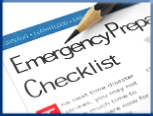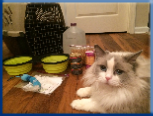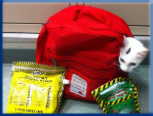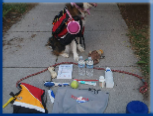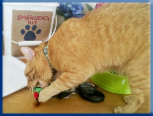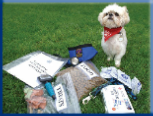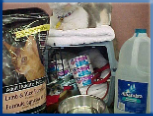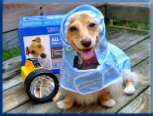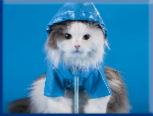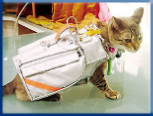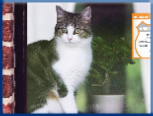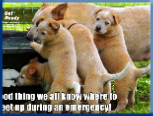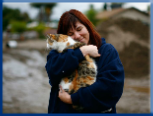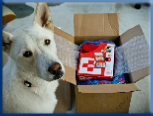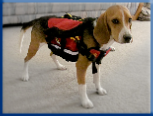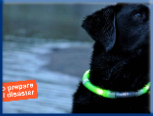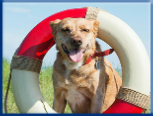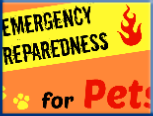


Copyright © 2013-2019 Campbell Village Veterinary Clinic. All rights reserved.


Phone: 972-931-9206
Fax: 972-380-1083











DISASTER PREPAREDNESS FOR YOUR PET

Dental prophylaxis is a treatment for periodontal disease as well as for disease prevention. We want to keep your pet’s teeth and mouth as healthy as possible, thus each prophylaxis includes the following:
- A general exam before anesthesia, including evaluation of the bite, pre-anesthetic bloodwork (if requested), and the identification of abnormal wear patterns, gum infection, tumors, etc. We strongly recommend the pre-anesthetic bloodwork which helps us to better evaluate your pet’s current health status and to ensure safe anesthesia.
- An oral exam under anesthesia.
- Removal of plaque and tartar deposits (scaling) above and below the gum-line using special hand instruments and electronic devices.This is performed under general anesthesia, providing immobilization of the pet and pain control. Intubation allows for the administration of anesthesia and prevents the pet from inhaling bacteria-laden particles as they are removed from the teeth.
- Any pockets below the gum-line are rinsed to eliminate debris and prevent abscesses. They may also be treated with a long acting doxycycline polymer (long acting antibiotic).
- Tooth polishing with fluoride. Polishing provides a smooth surface to which plaque and tartar do not as easily adhere.
- Application of Oravet Sealant, if requested (strongly recommended).
- Digital radiographs as recommended.
- Dental charting for the medical record.
- Preventive therapy as recommended.

Periodontal disease is an oral inflammatory disease, or infection, of the tissues that support the teeth (periodontium) and the gums (gingiva). The disease destroys the tissues, causing the gums to retract, resulting in roots that are bared and the formation of pockets beneath the gums. In advanced cases, abscesses can form in the pockets. The infection causes progressive bone loss around the teeth, loosening of the teeth, and eventual tooth loss.
Periodontal disease is caused by the accumulation of plaque and tartar (calculus) on the teeth and supporting tissue. Plaque develops when bacteria accumulate and combine with saliva to form a film that coats the teeth and gums. The disease includes both gingivitis and periodontitis and may be transmitted by the circulatory system to other areas of the body, such as the heart, liver, lungs, and kidneys, where it can cause life-threatening damage.
Inflammation of the gums (gingiva), without loss of supporting structure(s) of the teeth, which may or may not be visible to the eye.
A destructive process involving the loss of supporting structures of the teeth.
Periodontal disease is one of the most common, most diagnosed, most often recognized health problems among pets. More than 80% of dogs and 70% of cats develop the disease by the age of three. Poor oral hygiene, tooth alignment and pressure, systemic health, breed, and age all contribute to periodontal disease.
We recommend Royal Canin Veterinary Dental Diet. It contains a unique blend of plaque-reducing nutrients and a sequestering agent to reduce tarter. The mechanical action of the kibble reduces plaque, and it is available in two kibble sizes specifically designed for adult dogs weighing more than or less than 25 pounds.
Oravet is an odorless, tasteless, invisible, safe sealant. It is applied in a concentrated form with a bonding agent after the pet’s teeth are cleaned. This creates an invisible barrier that prevents bacteria from attaching to the tooth surface. It should be professionally reapplied every 6-12 months for best results. Oravet Plaque Prevention Gel should be used in conjunction with the Sealant and is easily applied at home once weekly.
Brushing your pet’s teeth daily will remove plaque buildup before it has a chance to mineralize into tartar. Correlate home oral care with something positive and be patient when initiating brushing your pet’s teeth. Do not use human toothpaste; it is toxic due to its high fluoride content and contains detergents that are not meant to be swallowed. It is best to use a brush and toothpaste designed for pet use. Avoid forceful restraint of your pet. And be sure to always praise and reward your pet for his cooperation. To brush his teeth:
- Put him at ease and make him comfortable
- Apply toothpaste to the brush, pressing it into the bristles so that he cannot easily lick it off
- Hold the brush at a 45 degree angle to teeth
- Brush his teeth using a circular motion
- Concentrate on brushing where the gums and teeth meet
- Start at the sides of the mouth and work to the front
Pets can get cavities, but they are relatively rare. Cats do sometimes suffer from painful lesions that are referred to as “cat cavities.”
Your pet will need his teeth cleaned anytime there is an accumulation of plaque and tartar. A consistent at-home oral care program, including daily brushing, a dental kibble diet, Oravet Prevention Gel, CET Hextra Chews, and/or CET Oral Rinse, can slow this accumulation. Remember that plaque and tartar contain bacteria that will irritate the gums, causing gingivitis. Left untreated, the gingivitis will progress to periodontitis. Professional cleanings are also required when there are indications of infection or the presence of periodontal disease. Your pet should have an oral exam as part of his annual exam or more frequently as recommended by the doctor.
We use the safest anesthetic agents, just like you would receive if you required a sedated procedure. We strongly recommend the pre-anesthetic bloodwork which helps us better evaluate your pet’s current health status. While anesthetized, your pet’s pulse, heart, and respiratory rates and blood pressure are monitored.
In early stages, removal of tartar attached to the teeth above and below the gumline, and possibly antibiotic treatment, will help restore oral health. Following professional cleaning, an at-home program of oral hygiene care can help maintain the pet’s oral health and lengthen the periods between professional cleanings. In advanced cases, either surgery or tooth extractions may be performed in addition to the scaling and polishing, along with antibiotics to help control the progression of the disease.
Periodontal disease is progressive and incurable if not controlled, but it is preventable and manageable with proper treatment techniques.
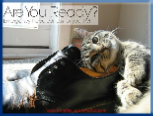
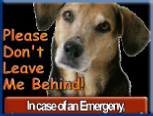


ENSURING YOUR PET’S SAFETY BEFORE AND AFTER A CATASTROPHE
Obviously, our pets are important to us, and we want to do what we can to keep them safe. No one is immune to the possibility of being personally affected by a disaster, but we can be proactive by preparing ourselves in advance and having a plan of action in case of emergency. What is best for us is usually what is best for our pets.
Investigate what types of disasters your area is most susceptible. Here in the Dallas area we are most concerned about flash flooding and tornadoes, but we should also plan for non-natural disasters like fires, gas leaks, hazardous materials spills, terrorist attacks, etc.
Place stickers on the front and back doors of your home to alert neighbors, police, fire and other rescue personnel that you have pets on your property that need to be rescued in your absence. Free stickers may be obtained through www.aspca.org. You might wish to include the location of your evacuation kit and the location of your pet’s favorite hiding place to save time. If you live in an apartment, verify that your pets are on record with the management office.
Having identification on your pets may help you reunite should you become separated. Provide your name, home address, phone number, and if possible, your veterinarian’s name, location, and phone number. Remember to include rabies and license tags. Consider also putting a piece of duct tape or another tag with the name and phone number of a friend or relative living out of state to contact in case you are unavailable in your home area for several days. A microchip is an excellent source of permanent identification that will not become lost in the confusion of a crisis. If your pet has a microchip, make sure to register the chip number with the database and keep your information on file with them current.
Put together an animal evacuation kit. The kit should be organized in an easily portable, waterproof container and kept in an accessible location. Replace food, water, and medications every six months to maintain quality and take an inventory yearly to make sure that the supplies continue to meet your pets’ needs. The following items are suggested by the AVMA:
- 2-week supply of food (dry & canned)
- 2-week supply of water in plastic gallon jugs with secure lids
- Batteries (flashlight, radio)
- Cage/carrier for each animal (labeled with your contact information)
- Can opener (manual)
- Cat/wildlife gloves
- Copies of veterinary records and proof of ownership
- Emergency contact list
- Familiar items to make pets feel comfortable (favorite toys, treats, blanket)
- First aid kit. See article
- Flashlight
- Instructions
- Diet: record the diet for each individual animal, including what not to feed in case of allergies
- Medications: list each animal separately, including dose and frequency of each medication. Provide vet and pharmacy info for refills.
- Leash and collar or harness (for each animal)
- Litter, pan, scoop
- Maps of local area and alternate evacuation routes (in case of road closure)
- Muzzles (dog and/or cat)
- Newspaper (bedding, litter)
- No-spill food and water dishes
- Paper towels
- Radio (solar, hand crank, and battery powered)
- Spoon (for canned food)
- Stakes and tie-outs
- Trash Bags
- Pre-signed letter releasing an assigned neighbor from responsibility if one of your pets is injured during an evacuation
- Pre-signed veterinary medical treatment authorization
- Vaccination records (type and date administered, Rabies certificate)
- Medical history or records (medical conditions and medications, important test results, record of microchip number)
- List of important emergency contacts (keep one copy near a phone in your home and one copy in the evacuation kit). See below.
- Copies of registration information, adoption papers, proof of purchase, microchip information. For each pet, list his species, breed, age, sex, color, and any distinguishing characteristics.
- Current photos of each pet for identification purposes. Include yourself in some of the photos.
Choose a neighbor to be a temporary caregiver to your pets in the event that a disaster occurs when you are not home. This person should have a key to your home, be familiar with your home and your pets, know your evacuation procedures, and know where your evacuation kit is stored.
Create a list of emergency contacts, including addresses and contact numbers. Keep one copy near your telephone and one in your evacuation kit.
- Numbers where you may be reached (pager, cell, work phone)
- Your prearranged evacuation site
- Local contact person in case of emergency when you are not available
- Out of state contact person
- Your veterinarian’s name, clinic name, and phone number
- Boarding facility (local and elsewhere)
- Hotels that allow pets (local and elsewhere)
- Local animal control
- Police department
- Fire department
- Public health department
- Local animal shelter
- Local Red Cross chapter
- Local humane society
- Local SPCA
- List of internet “Lost and Found” animal sites
Prearrange an evacuation site for your family and pets outside your immediate area. Keep in mind that most community shelters will not allow pets.
- Seek out preferred boarding kennels and facilities.
- Ask the local animal shelter if they provide emergency shelter/foster care for pets.
- Find hotels and motels outside of your immediate area that accept pets.
- Locate friends and/or family outside of your immediate area that would be willing to take in your pet.
When recommendations for evacuation are announced, follow the instructions of local and state officials. Evacuate as early as possible and plan for the worst-case scenario.
To prepare for a potential tornado, pick a “safe room” well in advance, usually a first floor interior room or a below-ground shelter. These rooms should be clear of hazards such as windows, flying debris, etc.
- Train dogs to go to the designated “safe room” ahead of time so that it is routine during a tornado warning. Make it a positive experience and practice until you get your timing down to 2 minutes or less if possible.
- Place cats in carriers once a watch is issued and bring them with you & the dogs to the “safe room” in the event a warning is issued.
- A large blanket or quilt placed over your heads will help protect you and your pets from dangerous flying glass and debris.
In the event of flooding, go to the highest location in your home, or a room that has access to counters or high shelves where your animals can take shelter.
After a disaster:
- Survey the area inside and outside your home thoroughly
- Examine you pets closely and contact your veterinarian immediately if you observe injuries or signs of illness.
- Walk your pets on a leash until they become reoriented to their home. Familiar scents and landmarks may have changed, and pets can become scared, disorients, aggressive, or defensive. Watch them closely and keep them under your direct control.
- Downed power lines, high water, debris, and displaced wild animals can all pose threats to you and your pets.
- If your pet is lost, physically check with animal control and animal shelters daily. Post waterproof lost notices and notify local law enforcement, animal control, veterinarians, and your neighbors.
